Research on the Defect Detection Method of Steel-Reinforced Concrete Based on Piezoelectric Technology and Weight Analysis
Abstract
1. Introduction
2. Internal Defect Detection Principle of Steel-Reinforced Concrete Based on Piezoelectric Technology and Weight Analysis
2.1. Stress Wave Analysis Based on the Principle of Wave Method
2.2. Wavelet Packet Energy Correction Based on Band Energy Ratio and Entropy Normalization
2.3. Basic Principle of Damage Index Based on Weight Influence Coefficient
3. Study on the Performance of the Defect Detection Method in Concrete Specimen Based on Piezoelectric Technology and Weight Analysis
3.1. Structure and Preparation of the Piezoelectric Sensor
3.2. Experimental Design and Specimen Making
3.3. Test Monitoring System
4. Test Result Analysis
4.1. Concrete Grades
4.2. Detection Range
4.3. Steel Plate Barrier
4.4. Layout of Measuring Points
4.5. Defect Size
5. Steel-Reinforced Concrete Column Defect Detection Test
5.1. Specimen Design and Measuring Point Arrangement
5.2. Test Monitoring Results
6. Conclusions
- The multi-dimensional feature fusion of the signal is achieved by designing the composite correction coefficient through the normalization of the frequency band energy proportion and entropy value, maintaining a high noise suppression ability while retaining the effective features. The composite coefficient highlights the key frequency bands of stress wave impact and upholds high-frequency noise. The weight of the noise frequency band is reduced through entropy inverse weighting. Meanwhile, the entropy value is combined to reflect the energy distribution characteristics, enhancing the noise resistance while optimizing the energy instability caused by the fluctuation of signal amplitude;
- The difference in stress wave signal amplitude under different concrete strength grades is less than 10%, which indicates that the structural health detection method based on piezoelectric sensors is applicable to the detection of concrete structures within the strength range of C40 to C70;
- Based on the comprehensive test results of the test block and the SRC model column, the signal energy intensity decreases exponentially with the increase in the detection distance. The transformation of steel and concrete media during the propagation of stress waves will lead to a reduction in the voltage response obtained by the piezoelectric sensor and attenuation of the propagation energy. With the increase in the gap width and the number of obstacles, the signal energy value attenuates from 4456.1 V2 to 88.849 V2. When the defect size is greater than 7 mm, the structure is considered severely damaged, and piezoelectric sensors are unable to collect more signal energy for wave propagation;
- Combining the influence of spectral characteristic changes on the calculated values of different damage metrics, the DI of the multi-damage factor comprehensive linear regression model based on weight analysis is proposed. The weighted defect index has more advantages in identifying minor damages compared to using CCD. The DI increases from 0 to 0.859 as the severity of the defect intensifies. The calculation results are consistent with the defect settings in the test. The effectiveness of damage evaluation indicators in the health detection of steel-reinforced concrete structures has been verified. It is also verified that when DI > 0.8, the structure is severely damaged. In practical engineering applications, this indicates significant damage inside the structure, and reinforcement measures need to be taken in a timely manner;
- The defect detection method of steel-reinforced concrete based on piezoelectric technology and weight analysis obtained in this study still requires a large amount of on-site data verification. It is suggested that in future research, a systematic study should be conducted on the value range for defect evaluation indicators to identify the severity of internal damage in steel-reinforced concrete structures.
Author Contributions
Funding
Institutional Review Board Statement
Informed Consent Statement
Data Availability Statement
Conflicts of Interest
References
- Cacciuttolo, C.; Muñoz, E.; Sotil, A. Technological Evolution of Architecture, Engineering, Construction, and Structural Health Monitoring of Bridges in Peru: History, Challenges, and Opportunities. Appl. Sci. 2025, 15, 831. [Google Scholar] [CrossRef]
- Liu, Q.; Xu, B.; Xia, Z.; Chen, Z.; Yao, Y.; Wang, J. Interface debonding defect detection for CFST columns based on EMI measurements: Experiment, numerical simulation and blind inspection in practice. Adv. Struct. Eng. 2024, 27, 1151–1169. [Google Scholar] [CrossRef]
- Yassin, M.H.; Farhat, M.H.; Soleimanpour, R.; Nahas, M. Fiber Bragg grating (FBG)-based sensors: A review of technology and recent applications in structural health monitoring (SHM) of civil engineering structures. Discov. Civ. Eng. 2024, 1, 151. [Google Scholar] [CrossRef]
- Hong, C.; Xu, C.; Chen, W.; Liu, J.; Tan, J. Monitoring Excavation-Induced Deformation of a Secant Pile Wall Using Distributed Fiber Optic Sensors. Sensors 2025, 25, 254. [Google Scholar] [CrossRef] [PubMed]
- Tanveer, M.; Elahi, M.U.; Jung, J.; Azad, M.M.; Khalid, S.; Kim, H.S. Recent Advancements in Guided Ultrasonic Waves for Structural Health Monitoring of Composite Structures. Appl. Sci. 2024, 14, 11091. [Google Scholar] [CrossRef]
- Lima, H.M.; Neto, J.A.D.F.; Haach, V.G.; Neto, J.M. Physical and mechanical properties of cement-lime mortar for masonry at elevated temperatures: Destructive and ultrasonic testing. J. Build. Eng. 2025, 104, 112291. [Google Scholar] [CrossRef]
- Mardanshahi, A.; Sreekumar, A.; Yang, X.; Barman, S.K.; Chronopoulos, D. Sensing Techniques for Structural Health Monitoring: A State-of-the-Art Review on Performance Criteria and New-Generation Technologies. Sensors 2025, 25, 1424. [Google Scholar] [CrossRef]
- Feng, Q.; Liang, Y. Development of piezoelectric-based technology for application in civil structural health monitoring. Earthq. Res. Adv. 2023, 3, 54–61. [Google Scholar] [CrossRef]
- Akgun, S.; Ali, H.Q.; Senol, C.O.; Yildiz, M. Experimental and numerical analysis of damage progression in composite cylinders with cutouts under combined loading using structural health monitoring techniques. Compos. Struct. 2024, 354, 118829. [Google Scholar] [CrossRef]
- Mo, D.; Zhang, L.; Wang, L.; Wu, X. A new PZT-enabled device for monitoring prestress loss in post-tensioned prestressed structures. Nondestruct. Test. Eval. 2024, 39, 2234–2250. [Google Scholar] [CrossRef]
- Narayanan, A.; Duddi, M.; Kocherla, A.; Kvl, S. Smart and autonomous monitoring of cracking in concrete structures with PZT sensor array-based hybrid sensing. Structures 2024, 68, 107178. [Google Scholar] [CrossRef]
- Naoum, M.C.; Papadopoulos, N.A.; Sapidis, G.M.; Voutetaki, M.E. Efficacy of PZT Sensors Network Different Configurations in Damage Detection of Fiber-Reinforced Concrete Prisms under Repeated Loading. Sensors 2024, 24, 5660. [Google Scholar] [CrossRef] [PubMed]
- De Luca, A.; Minardo, A.; Aversano, A.; Vallifuoco, R.; Sepe, R.; Caputo, F. Health and load monitoring in an aluminium plate through guided waves. Procedia Struct. Integr. 2024, 52, 424–429. [Google Scholar] [CrossRef]
- Dziendzikowski, M.; Kozera, P.; Kowalczyk, K.; Dydek, K.; Kurkowska, M.; Krawczyk, Z.D.; Gorbacz, S.; Boczkowska, A. Structural Health Monitoring of Chemical Storage Tanks with Application of PZT Sensors. Sensors 2023, 23, 8252. [Google Scholar] [CrossRef]
- Yang, W.; Lv, B.; Meng, H.; Yang, X. Bonding performance monitoring between CFRP and timber column interfaces based on piezoelectric ceramics. Smart Mater. Struct. 2023, 32, 2. [Google Scholar] [CrossRef]
- Wang, C.; Yang, Y.; Fan, G.; Lian, J.; Chen, F. Detection of Debonding Defects in Concrete-Filled Steel Tubes Using Fluctuation Analysis Method. Sensors 2024, 24, 8222. [Google Scholar] [CrossRef]
- Naoum, M.C.; Papadopoulos, N.A.; Voutetaki, M.E.; Chalioris, C.E. Structural Health Monitoring of Fiber-Reinforced Concrete Prisms with Polyolefin Macro-Fibers Using a Piezoelectric Materials Network under Various Load-Induced Stress. Buildings 2023, 13, 2465. [Google Scholar] [CrossRef]
- Quah, T.K.N.; Vo, T.V.K.; Tay, Y.W.D.; Tan, M.J.; Wong, T.N.; Li, K.H.H. Real Time Assessment of Smart Concrete Inspection with Piezoelectric Sensors. Electronics 2023, 12, 3762. [Google Scholar] [CrossRef]
- Kumar, M.K.; Anupam, R.; Rama, S. Performance evaluation concept for crack healing in bacterial concrete structure using electro mechanical impedance technique with PZT patch. Dev. Built Environ. 2023, 15, 100196. [Google Scholar] [CrossRef]
- Zhang, J.; Li, Y.; Du, G.; Song, G. Damage Detection of L-Shaped Concrete Filled Steel Tube (L-CFST) Columns under Cyclic Loading Using Embedded Piezoceramic Transducers. Sensors 2018, 18, 2171. [Google Scholar] [CrossRef]
- Zhang, H.; Wang, L.; Li, J.; Kang, F. Embedded PZT aggregates for monitoring crack growth and predicting surface crack in reinforced concrete beam. Constr. Build. Mater. 2023, 364, 129979. [Google Scholar] [CrossRef]
- Huang, T. Experimental Study on Damage Monitoring of RC Exterior Frame Joints Based on Embedded Piezoelectric Ceramic; Hunan University: Changsha, China, 2013. (In Chinese) [Google Scholar]
- Wu, C.; Fan, S.; Ma, S.; Chen, Z. Working mechanism of tubular PZT sensor and its application in damage monitoring of SRC rectangular column with unsymmetrical cross-shaped steel section. J. Build. Struct. 2023, 44, 215–224. [Google Scholar] [CrossRef]
- Ai, D.; Zhang, D.; Zhu, H. Damage localization on reinforced concrete slab structure using electromechanical impedance technique and probability-weighted imaging algorithm. Constr. Build. Mater. 2024, 424, 135824. [Google Scholar] [CrossRef]
- Song, G.; Olmi, C.; Gu, H. An overheight vehicle-bridge collision monitoring system using piezoelectric transducers. Smart Mater. Struct. 2007, 16, 462–468. [Google Scholar] [CrossRef]
- Chen, D.; Wang, Z.; Cheng, H.; Huo, L.; Song, G. Electro-mechanical impedance (EMI) based axial loads influence on damage of steel fiber concrete. Int. J. Sens. 2019, 1, 1002. [Google Scholar]
- Song, N.; Wu, F. Experimental Tests on Crack Detection of Reinforced Concrete Beam Using PZT Network. Res. Explor. Lab. 2016, 35, 4–8. [Google Scholar]
- Amit, T.; Tarak, V.; Vijay, M. Corrosion assessment in rebars of high-strength concrete using electromechanical impedance technique. Mater. Today Proc. 2022, 57, 2234–2241. [Google Scholar] [CrossRef]
- Li, Y. Research on Damage Identification Method of Concrete Structure Strengthened by UHPC Using Piezoelectric Ceramics; Chongqing University: Chongqing, China, 2023. [Google Scholar] [CrossRef]
- Zhou, Z.; Zhou, X.; Zhai, M.; Chang, J. Damage identification method of simply supported beam under environmental excitation based on wavelet packet energy curvature. J. Yangzhou Univ. 2024, 27, 62–68. [Google Scholar] [CrossRef]
- Lim, Y.Y.; Soh, C.K. Fatigue life estimation of a 1D aluminum beam under mode-I loading using the electromechanical impedance technique. Smart Mater. Struct. 2011, 20, 125001. [Google Scholar] [CrossRef]
- Lim, Y.Y.; Soh, C.K. Effect of varying axial load under fixed boundary condition on admittance signatures of electromechanical impedance technique. J. Intell. Mater. Syst. Struct. 2012, 23, 815–826. [Google Scholar] [CrossRef]
- Hassan, H.J.; Seyedsina, H.; Farshad, M. Optimum PZT Patch Size for Corrosion Detection in Reinforced Concrete Using the Electromechanical Impedance Technique. Sensors 2021, 21, 3903. [Google Scholar] [CrossRef] [PubMed]
- Wang, Z.; Zhang, X.; Qi, G.; Zhang, H.; Gao, M. Based on the optimization design of the frame structure health monitoring scheme of a project. Orientat. Build. Mater. Dev. 2025, 23, 31–33. [Google Scholar] [CrossRef]
- Bergman, J.; Li, F.; Cheung, C.; Kumar, A.; Oblea, L.; Price, W.; Jankly, S.; Sotoudeh, V.; Moslehi, B.; Cope, M. Integrated Hybrid Structural Health Monitoring System. In Structural Health Monitoring 2017; Sage Publications: Thousand Oaks, CA, USA, 2017. [Google Scholar] [CrossRef]
- Ren, Y.; Xu, Q.; Yuan, S. Improving accuracy of damage quantification based on two-level consistency control of PZT layers. Chin. J. Aeronaut. 2023, 36, 241–253. [Google Scholar] [CrossRef]
- Himanshi, G.; Saravanan, T.J. Structural Damage Detection through EMI and Wave Propagation Techniques Using Embedded PZT Smart Sensing Units. Sensors 2022, 22, 2296. [Google Scholar] [CrossRef]
- Lu, L.; Yu, H.; Qiao, P. Nondestructive Evaluation of Concrete Based on Stress Wave Propagation Mechanism: A Review. Chin. Q. Mech. 2021, 42, 197–216. [Google Scholar] [CrossRef]
- Yu, H.F.; Lu, L.J.; Qiao, P.Z.; Wang, Z. Actuating and sensing mechanism of embedded piezoelectric transducers in concrete. Smart Mater. Struct. 2020, 29, 085020. [Google Scholar] [CrossRef]



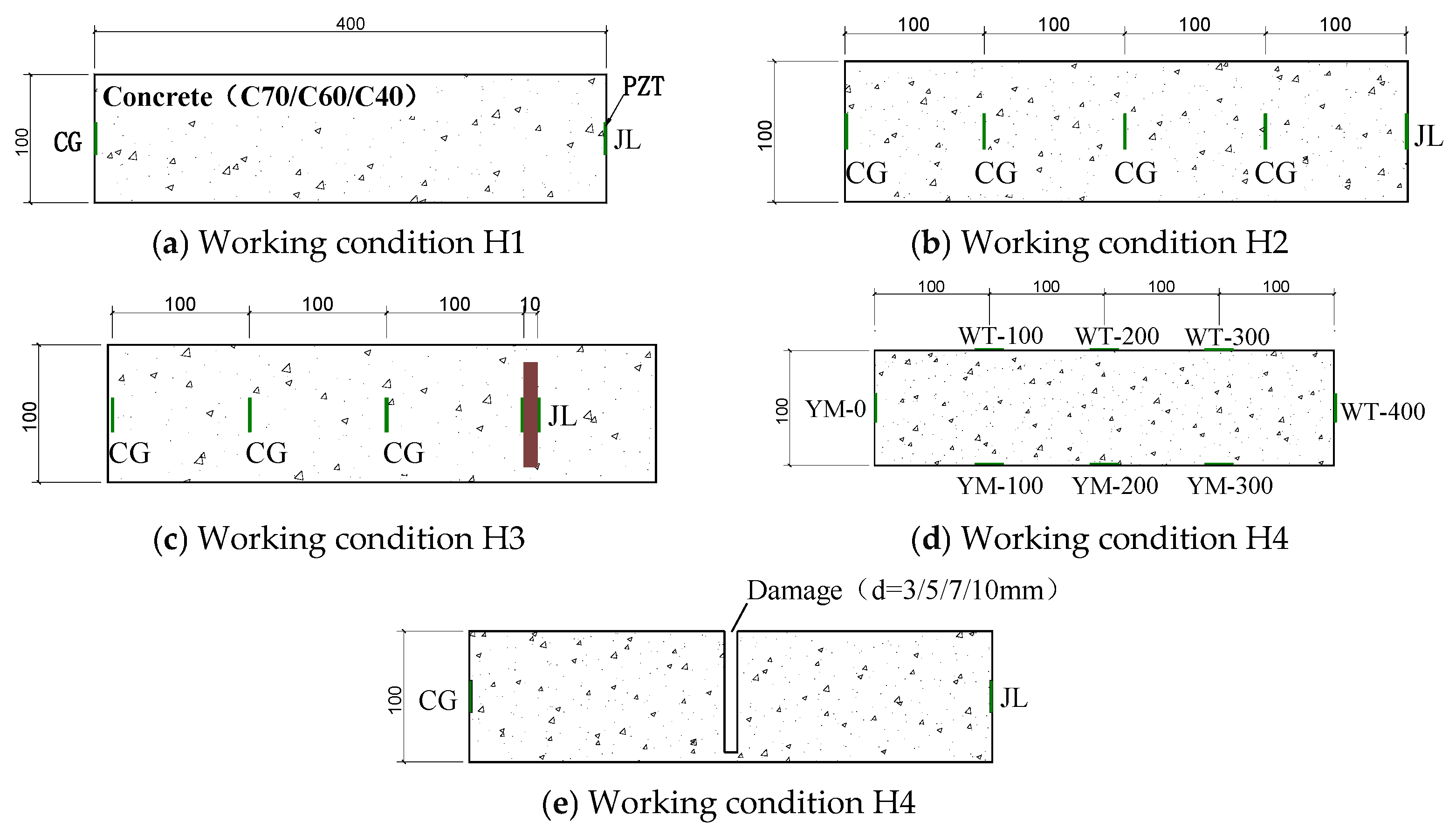

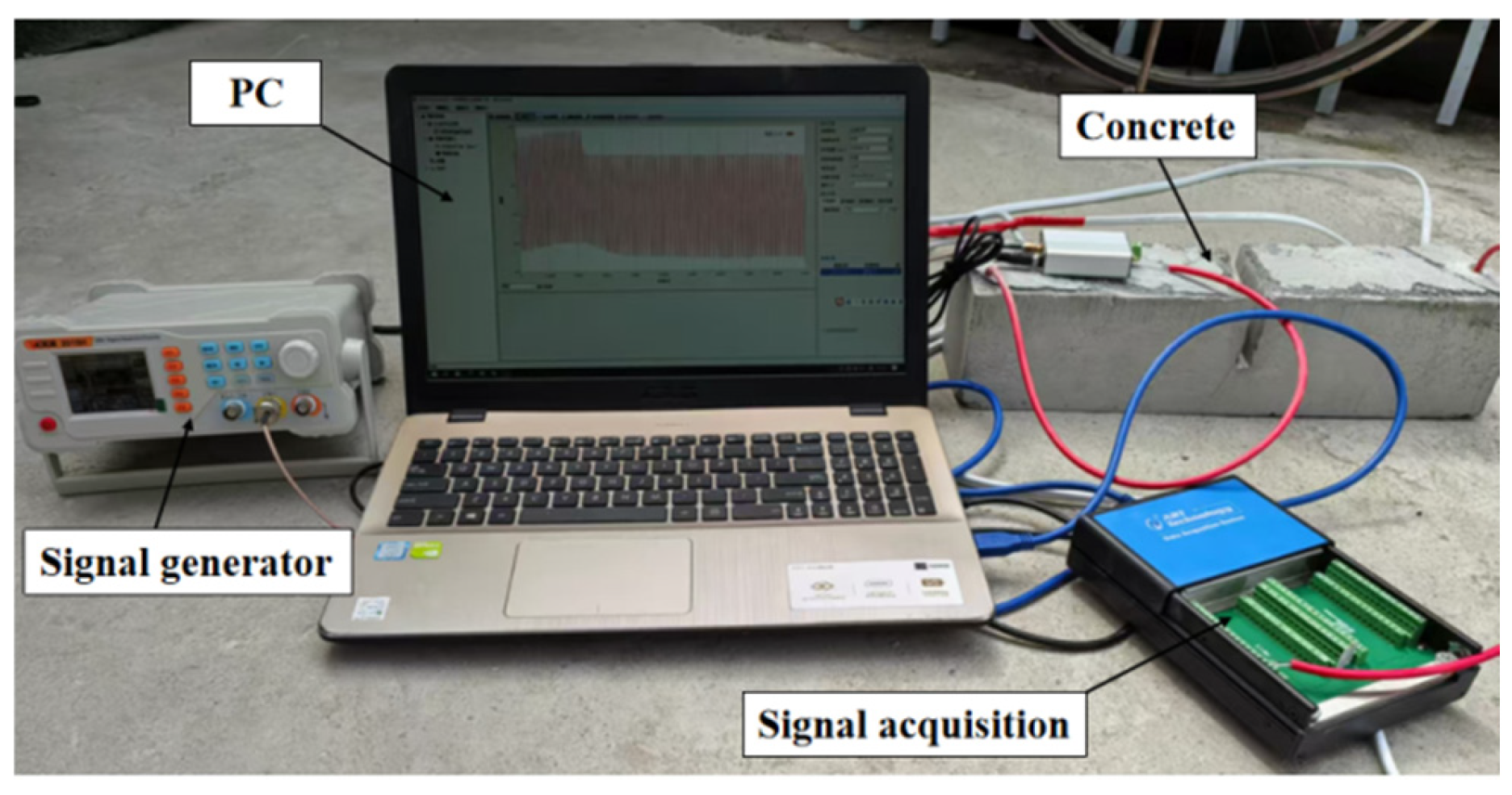

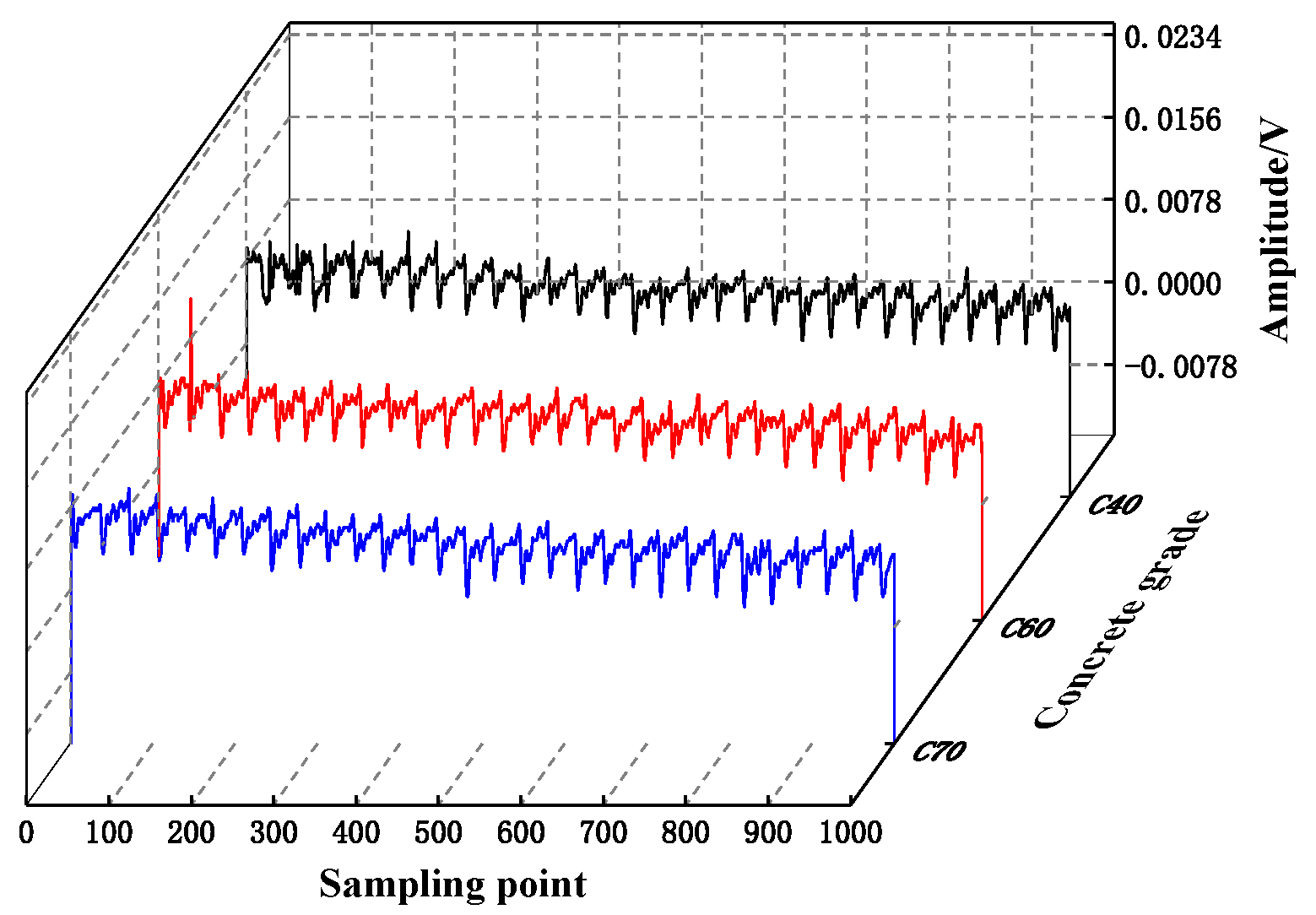
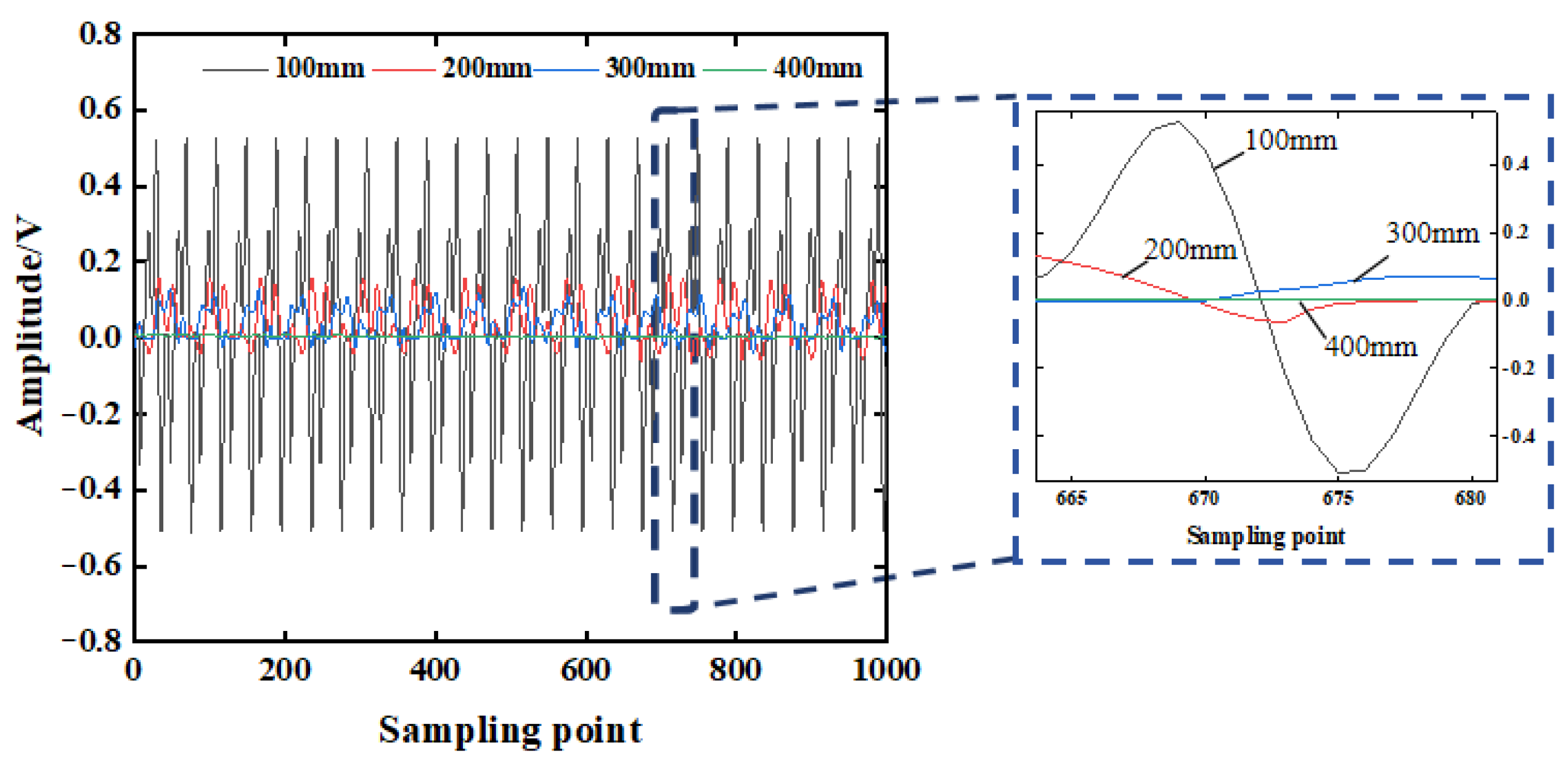


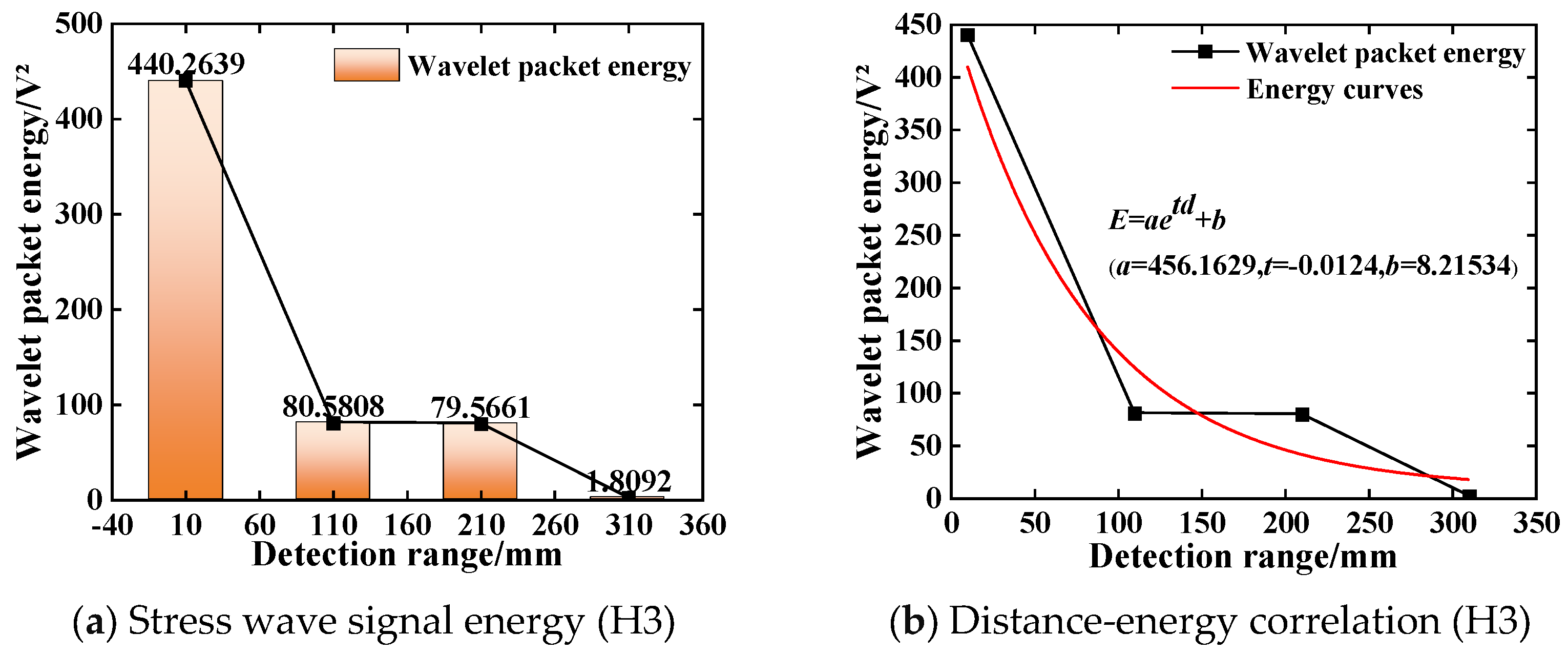

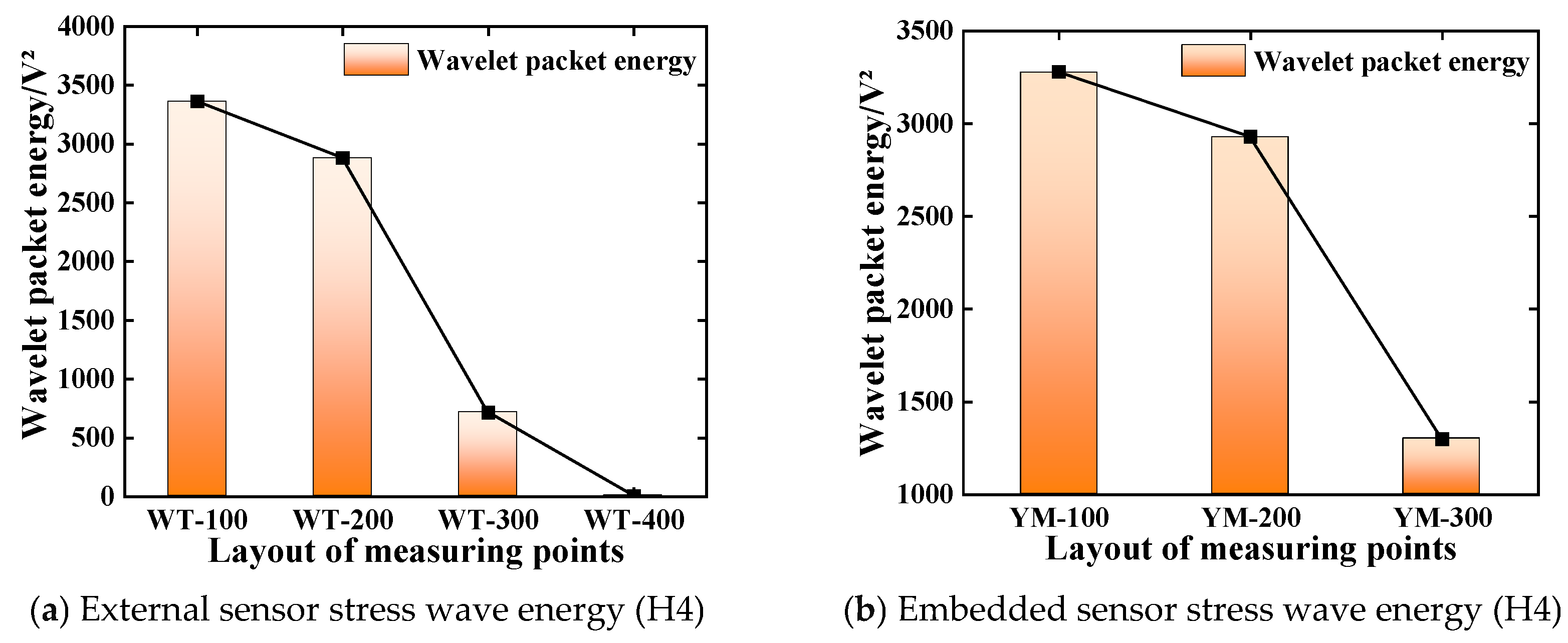
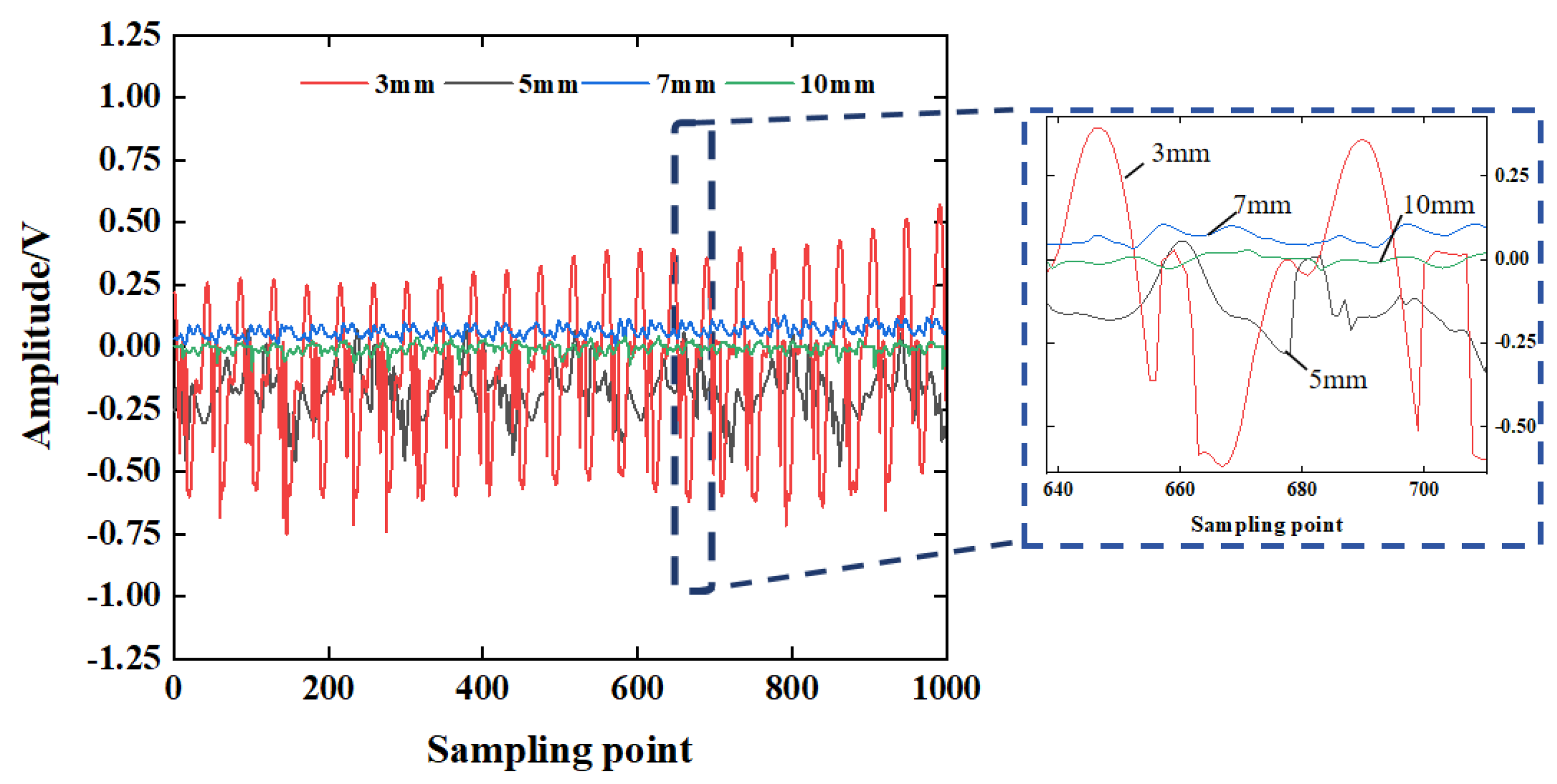
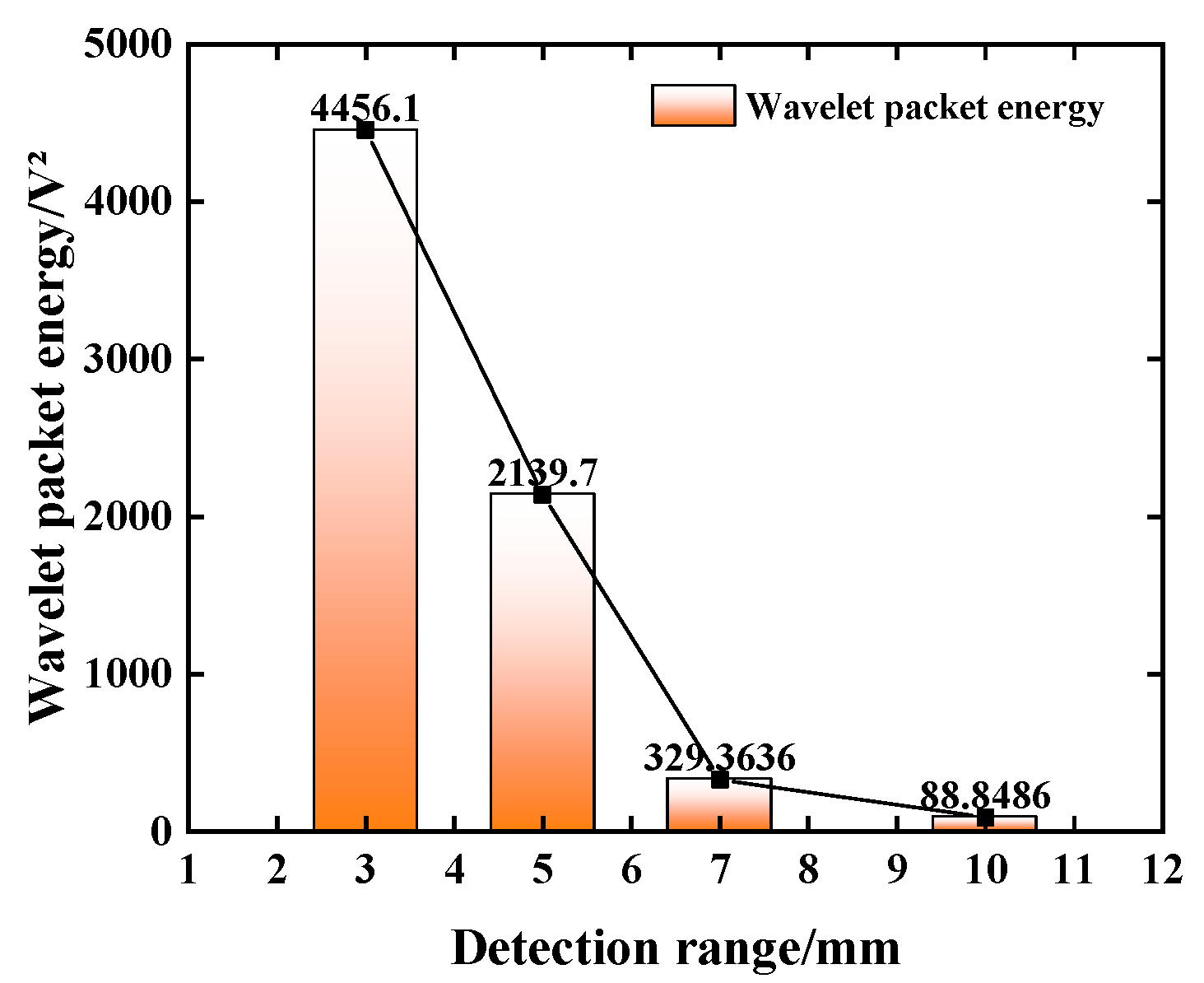
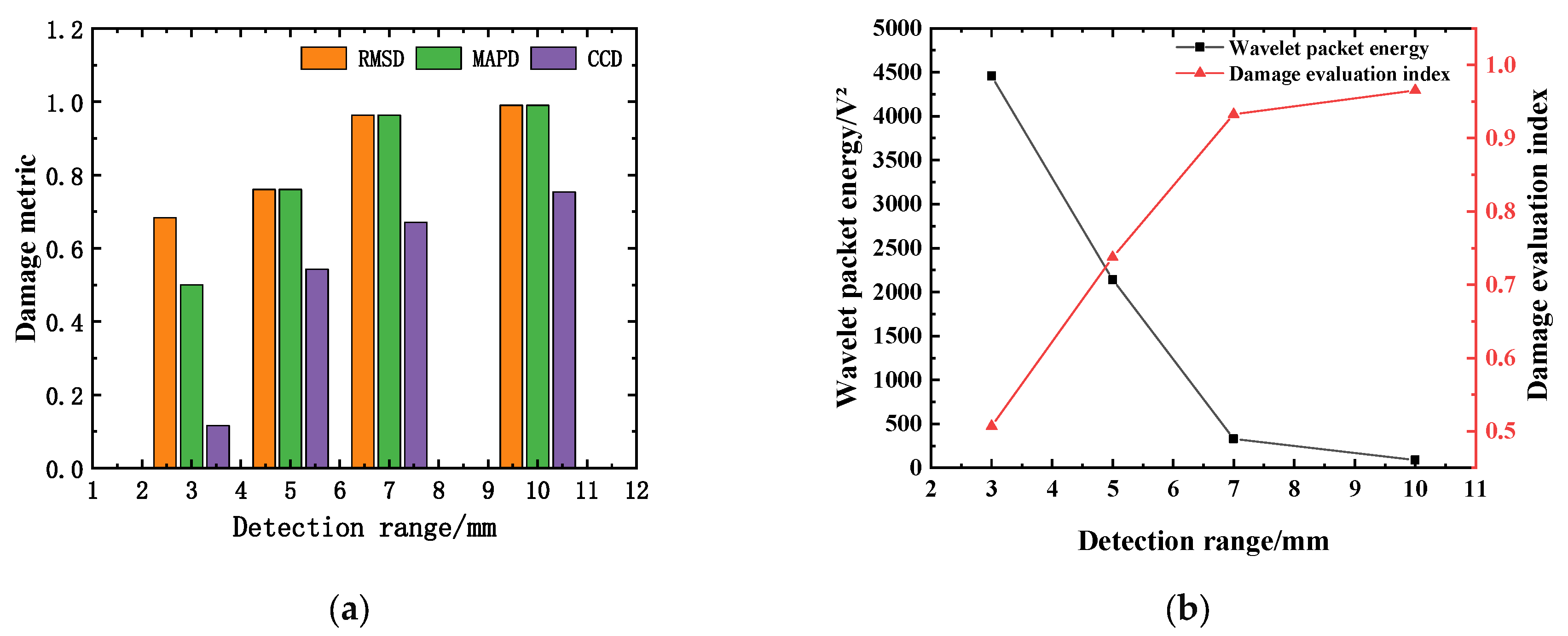




| RMSD | MAPD | CCD | |
|---|---|---|---|
| RMSD | 1 | 1/3 | 3 |
| MAPD | 3 | 1 | 5 |
| CCD | 1/3 | 1/5 | 1 |
| Order | 1 | 2 | 3 | 4 | 5 | 6 | 7 | 8 | 9 | 10 | 11 |
|---|---|---|---|---|---|---|---|---|---|---|---|
| RI | 0 | 0 | 0.58 | 0.9 | 1.12 | 1.24 | 1.32 | 1.41 | 1.46 | 1.49 | 1.52 |
| Performance Parameter | Taking Values |
|---|---|
| Electromechanical coupling coefficient | 0.70 |
| Dielectric constant ε33/ε0 | 2000 |
| Dielectric loss/% | 2 |
| Piezoelectric constant d33/(pC·N−1) | 450 |
| Density/(×103 kg/m3) | 7.6 |
| Mechanical quality factor | 75 |
| Poisson ratio | 0.36 |
| Specification Strength | fck/MPa | fc/MPa |
|---|---|---|
| C70 | 46.8 | 33.4 |
| C60 | 40.1 | 28.6 |
| C40 | 26.8 | 19.1 |
| Tag | Concrete Grades | Detection Distance/mm | Layout Form | Incident Angle of Wave | Defect Type | Defect Size/mm |
|---|---|---|---|---|---|---|
| H1 | C70 | 400 | Embedment | 0 | Zero defect | — |
| C60 | 400 | Embedment | 0 | Zero defect | — | |
| C40 | 400 | Embedment | 0 | Zero defect | — | |
| H2 | C70 | 100 | Embedment | 0 | Zero defect | — |
| C70 | 200 | Embedment | 0 | Zero defect | — | |
| C70 | 300 | Embedment | 0 | Zero defect | — | |
| C70 | 400 | Embedment | 0 | Zero defect | — | |
| H3 | C70 | 10 | Embedment | 0 | Steel plate | — |
| C70 | 110 | Embedment | 0 | Steel plate | — | |
| C70 | 210 | Embedment | 0 | Steel plate | — | |
| C70 | 310 | Embedment | 0 | Steel plate | — | |
| H4 | C70 | 100 | Externally bonded | 45° | Zero defect | — |
| C70 | 200 | Externally bonded | 27° | Zero defect | — | |
| C70 | 300 | Externally bonded | 18° | Zero defect | — | |
| C70 | 400 | Externally bonded | 0 | Zero defect | — | |
| C70 | 100 | Embedment | 45° | Zero defect | — | |
| C70 | 200 | Embedment | 27° | Zero defect | — | |
| C70 | 300 | Embedment | 18° | Zero defect | — | |
| D5 | C70 | 300 | Embedment | 0 | Gap | 3 |
| C70 | 300 | Embedment | 0 | Gap | 5 | |
| C70 | 300 | Embedment | 0 | Gap | 7 | |
| C70 | 300 | Embedment | 0 | Gap | 10 |
| Defect Size/mm | RMSD | MAPD | CCD | DI |
|---|---|---|---|---|
| 3 | 0.683 | 0.499 | 0.115 | 0.506 |
| 5 | 0.760 | 0.760 | 0.542 | 0.737 |
| 7 | 0.963 | 0.963 | 0.670 | 0.932 |
| 10 | 0.989 | 0.990 | 0.753 | 0.965 |
| Driver | Sensor | Wave Incident Angle | Number of Obstacles |
|---|---|---|---|
| A1 | B1 | 0 | 0 |
| A2 | B2 | 27° | 0 |
| A3 | B2 | 45° | 0 |
| A4 | B3 | 0 | 0 |
| A5 | B4 | 0 | 1 |
| A6 | B4 | 0 | 2 |
| A7 | B4 | 0 | 3 |
| Defect Condition | RMSD | MAPD | CCD | DI |
|---|---|---|---|---|
| 0 | 0 | 0 | 0 | 0 |
| 1 | 0.310 | 0.301 | 0.035 | 0.273 |
| 2 | 0.752 | 0.762 | 0.694 | 0.752 |
| 3 | 0.854 | 0.865 | 0.83619 | 0.859 |
Disclaimer/Publisher’s Note: The statements, opinions and data contained in all publications are solely those of the individual author(s) and contributor(s) and not of MDPI and/or the editor(s). MDPI and/or the editor(s) disclaim responsibility for any injury to people or property resulting from any ideas, methods, instructions or products referred to in the content. |
© 2025 by the authors. Licensee MDPI, Basel, Switzerland. This article is an open access article distributed under the terms and conditions of the Creative Commons Attribution (CC BY) license (https://creativecommons.org/licenses/by/4.0/).
Share and Cite
Yu, Y.; Dong, Y.; Jiang, Y.; Wang, F.; Zhou, Q.; Ba, P. Research on the Defect Detection Method of Steel-Reinforced Concrete Based on Piezoelectric Technology and Weight Analysis. Sensors 2025, 25, 3844. https://doi.org/10.3390/s25133844
Yu Y, Dong Y, Jiang Y, Wang F, Zhou Q, Ba P. Research on the Defect Detection Method of Steel-Reinforced Concrete Based on Piezoelectric Technology and Weight Analysis. Sensors. 2025; 25(13):3844. https://doi.org/10.3390/s25133844
Chicago/Turabian StyleYu, Yilong, Yulin Dong, Yulong Jiang, Fan Wang, Qianfan Zhou, and Panfeng Ba. 2025. "Research on the Defect Detection Method of Steel-Reinforced Concrete Based on Piezoelectric Technology and Weight Analysis" Sensors 25, no. 13: 3844. https://doi.org/10.3390/s25133844
APA StyleYu, Y., Dong, Y., Jiang, Y., Wang, F., Zhou, Q., & Ba, P. (2025). Research on the Defect Detection Method of Steel-Reinforced Concrete Based on Piezoelectric Technology and Weight Analysis. Sensors, 25(13), 3844. https://doi.org/10.3390/s25133844





